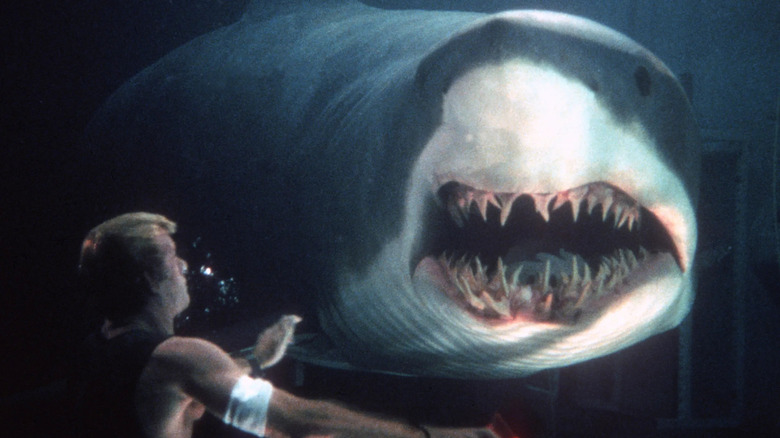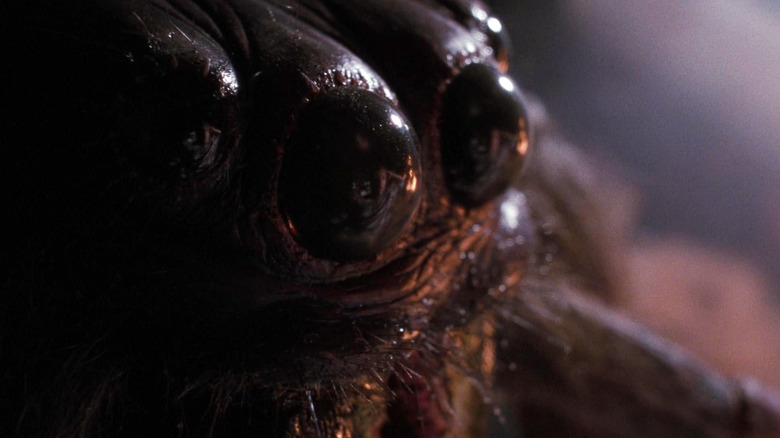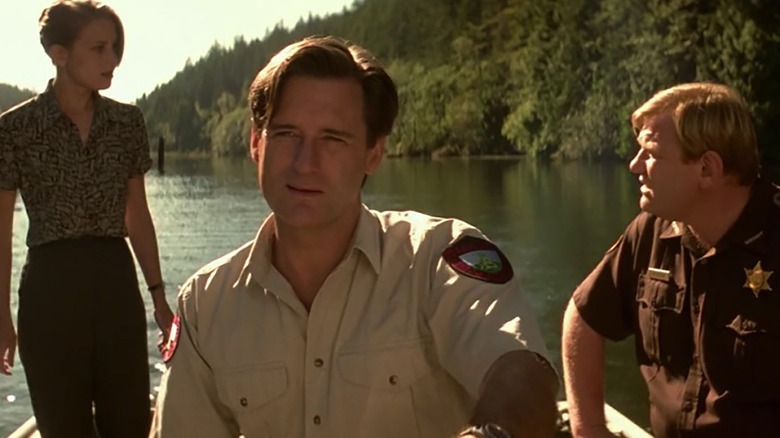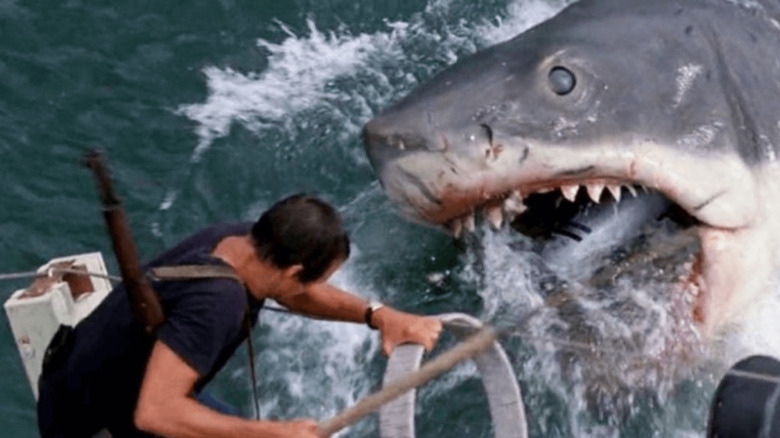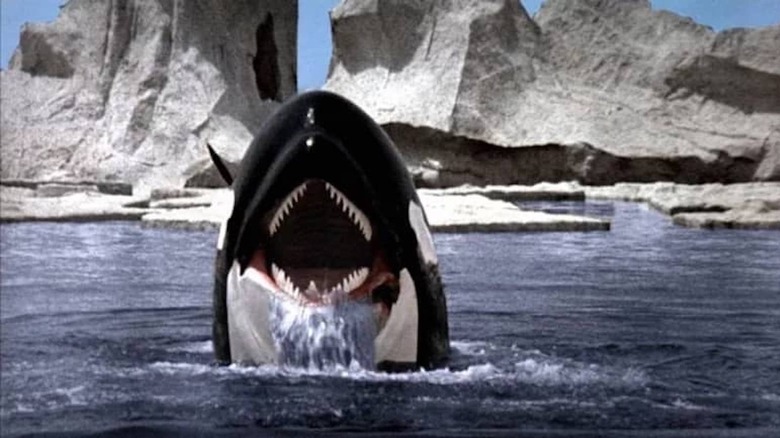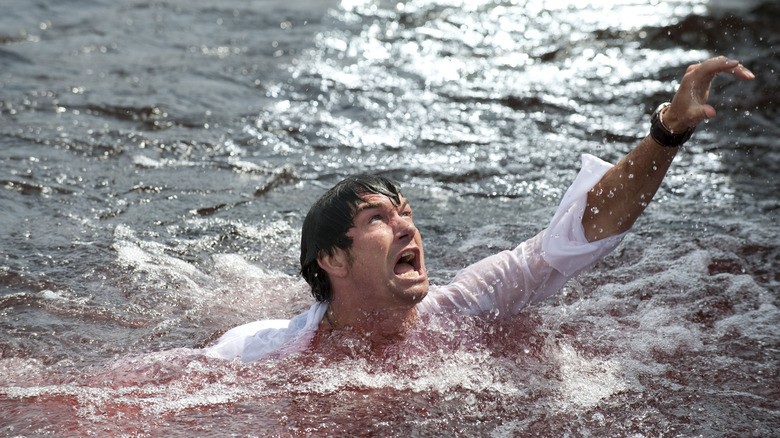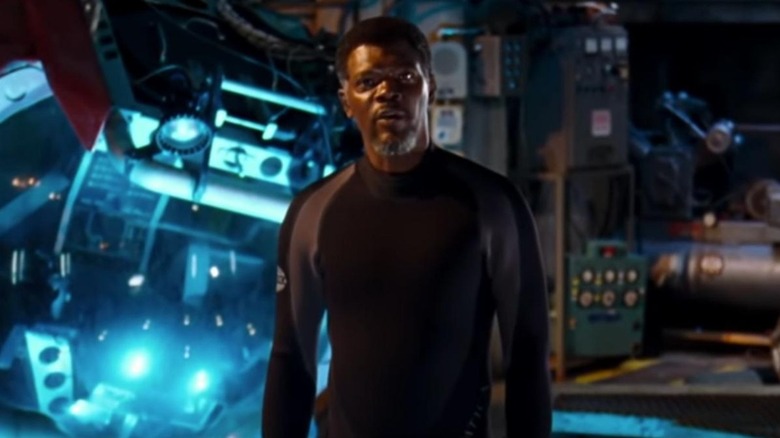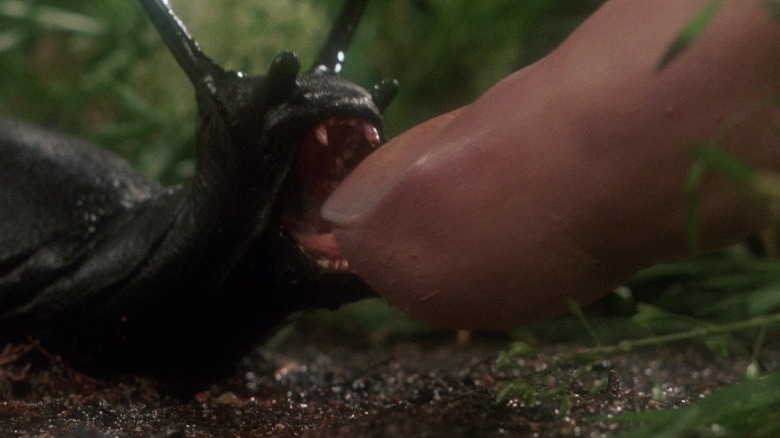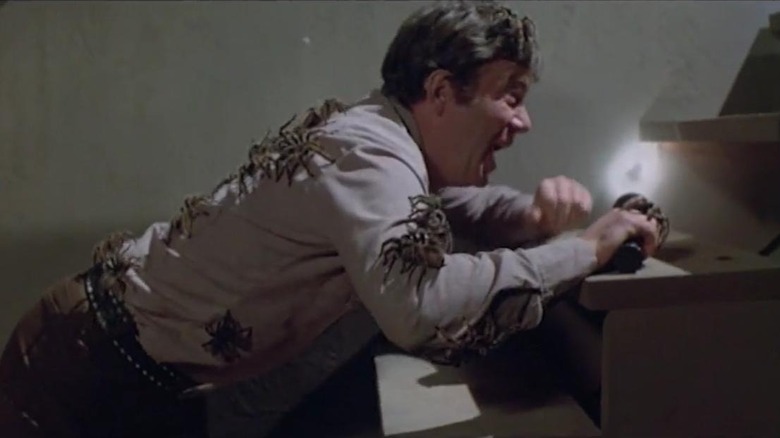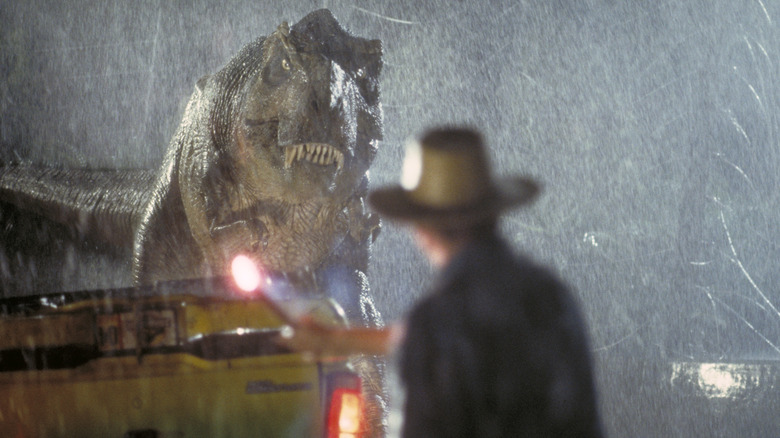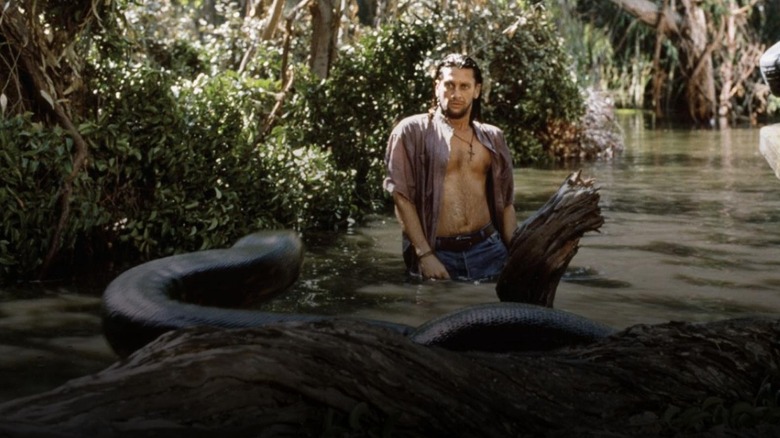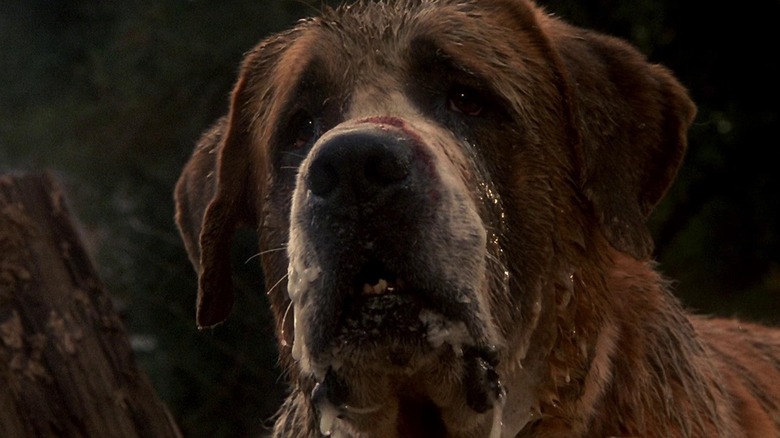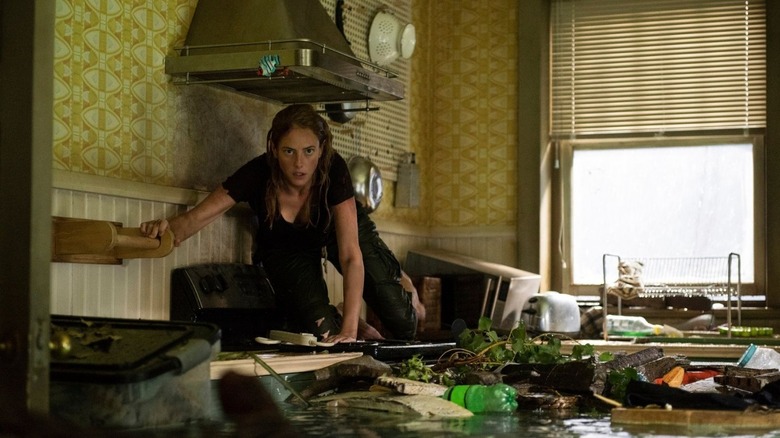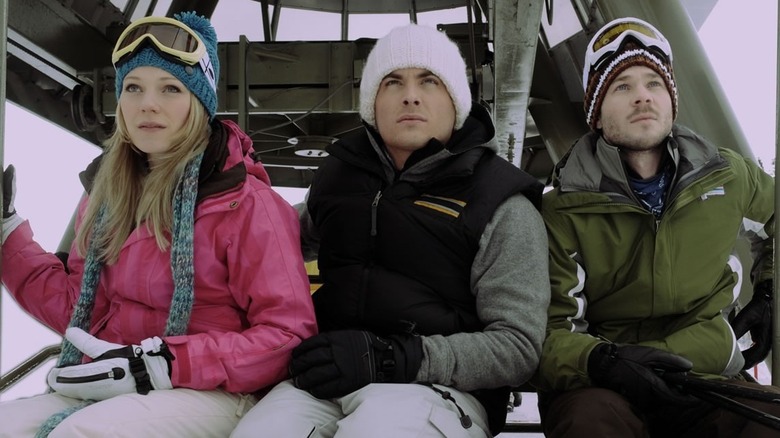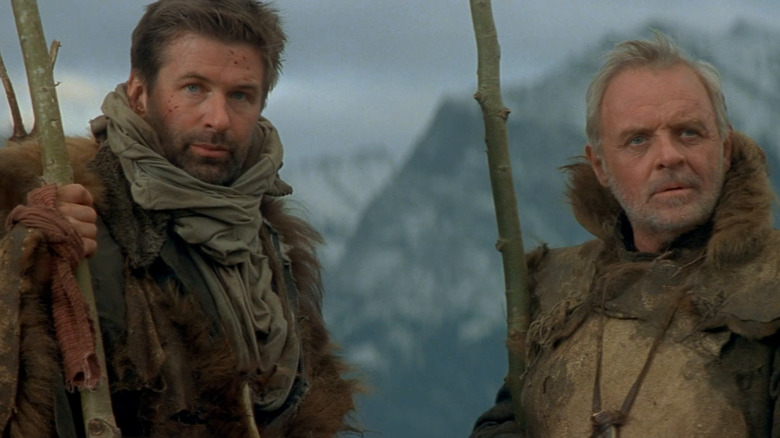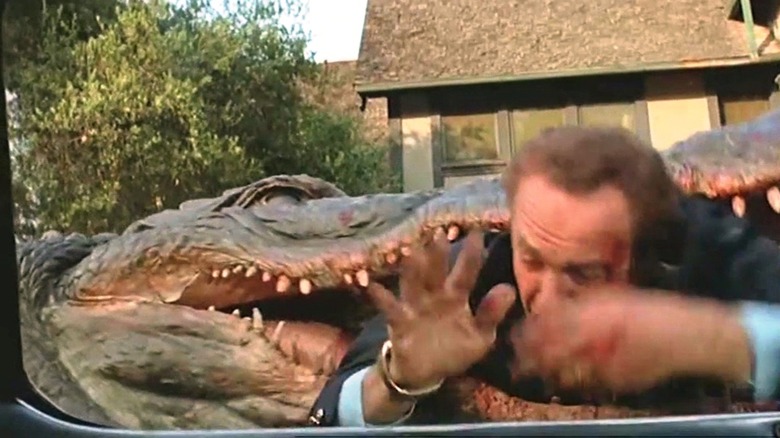The Most Savage Animal Attack Horror Movies
While aquatic horror specifically has a forever home firmly tucked into the summer months, there's something particularly (and twistedly) special about animal attack horror movies. From the absolutely ludicrous like the 1980 flick "Alligator," the Richard Harris-starring "Orca," and the so-bad-it's-good late-'80s romp "Slugs" to classic fare like "Jurassic Park," "Jaws," and "Cujo," there's genuinely something for everyone. Tensions are high as nature's mightiest (or slimiest) predators make quick work of their human prey, whether that's for a laugh, a political statement, or just a good old-fashioned scare-fest. And while the /Film team has a soft spot for virtually all entries in this cherished little subgenre, these 15 movies are the best and the gnarliest of the bunch.
Arachnophobia (1990)
Unfortunately, spider bites don't always kickstart superhero stories. Sometimes, they invade your home and poison you instead.
Perhaps the single best thing about Frank Marshall's 1990 horror black comedy "Arachnophobia" is that it doesn't need life-sized monsters to build tension and elicit a sense of fear in the hearts of viewers — the film achieves the exact same result by unraveling the story of a town besieged by thousands of small, venomous spiders. The newly discovered species begins killing off the town's residents one by one, leaving a trail of inexplicable deaths in its wake.
The Steven Spielberg-produced comic thriller delivers chills by exploiting the film's probability — it isn't that far-fetched to discover a spider crawling on the ceiling, to find one hidden away near the bathroom sink, or to find a web by the window. The film used actual arachnids, too — a harmless species from New Zealand known as Avondale spiders were used during the filming of "Arachnophobia."
While some spider enthusiasts were enraged that the film tarnished the public opinion of arachnids by portraying them negatively, others have maintained that the film is more enjoyable than terrifying. If you thought being attacked by a massive animal was a scary ordeal, think of this: you're living in complete peace, oblivious to the fatal danger that is infesting your town by the minute. Where do you hide when your house is full of them? (Fatemeh Mirjalili)
Lake Placid (1999)
Steve Miner's 1999 horror-comedy "Lake Placid" is a perfect example of its time; an over-the-top, occasionally exploitative backwoods romp that encapsulates all there is to love about turn-of-the-century creature features. The movie stars Bridget Fonda as Kelly Scott, a paleontologist from the city who goes out to the lake on an expedition after reported sightings of a prehistoric-sized crocodile. She's joined by a crocodile enthusiast Hector Cyr (played by Oliver Platt), but the two city slickers don't quite have what it takes to survive their trek into lake country without some help. Bill Pullman, Brendan Gleeson, and Meredith Salenger round out the cast as local law enforcement and fish and game authorities trying to battle the massive beast, but even they aren't quite prepared for what they're up against: the world's wildest little old lady, played by the legendary Betty White.
It turns out that White's character lives on the lake and feeds the killer croc. "Lake Placid" is as ferocious as it is funny, balancing moments of terror with its dark comedy. There are some nasty kills and great gory moments, but nothing is quite as fun as the reveal that the beloved Golden Girl was not only feeding the croc but that she fed him her husband. She also swears with the best of them, delivering lines with the confidence of a swaggering sailor despite looking like she should be baking cookies instead.
On top of a stellar cast and an all-timer performance by White, "Lake Placid" also features a truly terrific full-size animatronic crocodile, designed and built by the legendary Stan Winston and his team, who also designed the dinos for "Jurassic Park." "Lake Placid" is a perfect late-'90s throwback in every way. They just don't make movies like this anymore. (Danielle Ryan)
Jaws (1975)
Before the summer of 1975, only a few people on this planet had any idea what a shark attack looked or, god forbid, felt like. After that summer, whenever a beachgoer strayed into the ocean on a perfect July day, they could at any moment summon the terrifying image of Chrissie Watkins getting thrashed about the surface of the ocean or the godawful sound of little Alex Kintner's gurgled scream as he's dragged to his deep-blue death. Or they could simply call up John Williams's unforgettable two-note theme, at which point they're making like Michael Phelps for shore.
"Jaws" was a one-of-a-kind cinematic phenomenon that changed the way people thought about the ocean, for better and worse. Matt Hooper's skillfully written info dumps (masterfully delivered by Richard Dreyfuss) inspired a newfound fascination with the aquatic world and the animals that inhabit it. Unfortunately, as a result, great white sharks were suddenly feared as the apex predator of the sea, which led to a flurry of overfishing that threw a serious dent into the worldwide shark population.
This might sound like a lot to heap on what is, at heart, nothing more than an escapist horror-adventure, but Steven Spielberg is no ordinary genre technician. Arriving at the height of "New Hollywood" innovation, "Jaws" blended pricey practical effects (primarily that great big mechanical shark named Bruce) and old-school suspense tactics to both thrill and scar just about everyone who bought a ticket. No one was the same walking out of "Jaws." Anyone who says they can take a carefree dip in the ocean without wondering what's lurking beneath their toes is a full-on liar. (Jeremy Smith)
Orca (1977)
Rushed into production to capitalize on the "Jaws" phenomenon, Michael Anderson's "Orca" is a half-silly, half-sorrowful seafaring epic about a whaler (Richard Harris) who finds himself locked in a life-or-death struggle with a killer whale whose mate and offspring he inadvertently killed. Given the intelligence of whales, this payback scenario is a lot less risible than "Jaws The Revenge," but the screenplay by Luciano Vincenzoni and Sergio Donati goes hilariously overboard by turning the aggrieved mammal into an aquatic Rambo. The whale methodically destroys a coastal village's entire economy by sinking boats and driving away the fish that prop up its seafood exports. It also picks off Harris's crew one by one, and in one magnificent scene, busts the stilts off a bungalow so it can bite off Bo Derek's already broken leg.
This is one seriously peeved whale.
Harris ultimately has no choice but to pursue the whale into the treacherously icy waters off the coast of Newfoundland, which, of course, is precisely what his enemy desires.
"Orca" is such a strange movie. Though Harris is the film's protagonist, the viewer's rooting interest is always with the whale. How can it not be? The sequence where the female miscarries is legitimately traumatic. It's a shame Bo Derek's leg had to get mixed up in all of this, but that's what she gets for hanging out with a harpoon-happy jerk like Richard Harris. "Orca" strives to be a gory exploitation flick and an environmentally conscious screed (they even got Carol Connors to warble over Ennio Morricone's lovely main theme), but it's the latter aspiration that renders it a giddily enjoyable goof instead of a responsibly ecological answer to "Jaws." (Jeremy Smith)
Piranha 3D (2010)
With all due respect to Joe Dante's original "Piranha," director Alexandre Aja upped the stakes in many ways with his loose 2010 remake, "Piranha 3D." Inherent to the premise in both versions is a very dangerous animal, but that element was cranked up to 11 "Spinal Tap" style in Aja's version with the violent, prehistoric fish causing a big, bloody mess throughout most of the film.
The filmmaker didn't shy away from showing us one second of the carnage, either, as the remake is loaded with scenes that unambiguously let the audience know what they're dealing with. There are a few sequences that are particularly brutal. One involves Jerry O'Connell's sleazy porn producer, Derrick, being ripped in half by the sharp-toothed fish, and we get to see the "Stand By Me" star both before and after having his legs chewed off. It's pretty gruesome and shocking.
But Aja's biggest set piece comes at a time when the spring break party is interrupted by these beasts that have surfaced from far beneath the lake. This isn't one intimate encounter with a victim, either. It's an entire party's worth of people swimming for their lives, and many people don't make it out alive ... or intact. In "Jaws," the characters have to avoid one big shark. Here, they're escaping a pack of hungry predators that work together to make a mess of things, yielding a unique brand of animalistic brutality. (Ryan Scott)
Deep Blue Sea (1999)
Listen, at some point in our lives, we're all overcome with the irrational, paralyzing fear of being involved in a shark attack of sorts. The ocean is a place we don't know much about, and terror-inducing shark movies don't help matters. Renny Harlin's aquatic horror flick "Deep Blue Sea" is one such title, and you just know something truly terrible is about to go wrong when you learn that a group of scientists is working in an underwater facility ... with a bunch of sharks. Super-smart sharks, to boot.
The mayhem that unfolds in "Deep Blue Sea" is suspenseful, nerve-wracking, and incredibly entertaining. This is the kind of shark attack movie that leaves you on the edge of your seat, unaware of what comes next. The genetically-engineered sharks attack the research facility and eat its researchers — poor Samuel L. Jackson gets devoured while making a motivational speech. These big-brained predators swim backward and tear through anything that stands between them and their prey.
The film proves that shark movies make some of the most brutal animal attack flicks of all time. They're mysterious, frightening, and massive, and making them smarter than they already are just doesn't seem like a good idea. There are some questionable visuals and non-stop thrills that teether on the edge of absurdity, but "Deep Blue Sea" has all the toothy action you could expect from a shark-centric movie. (Fatemeh Mirjalili)
Slugs (1988)
"They ooze. They slime. They kill." 1988's "Slugs" is an American/Spanish horror film based on the novel of the same name by Shaun Hutson, about a small rural town that must defeat a growing army of millions of mutant, flesh-eating slugs that were birthed from a toxic waste dump in the town's water supply. If it sounds like "Slugs" is one of those 1980s "so-bad-it's-good" reimaginings of the b-movie monster flicks of the 1950s, it's because that's precisely the brand of brilliant ridiculousness set to screen. Rather than approach the film with any semblance of seriousness, "Slugs" leans heavily into the realm of deliciously campy exploitation, as aggressive slug monsters terrorize humans and turn them into blood-red clumps of viscera.
This creature feature boasts a script that was likely cobbled together using safety scissors and random magazine cut-outs in an attempt to tell a story, reveling in just about every monster movie cliche ever put to screen. Despite it all, "Slugs" remains an absolute blast and a half, with all of the film's technical shortcomings only enhancing the experience. People cut off their own limbs in an attempt to stop them, slugs explode from someone's face in the middle of a business meeting, and this is merely the tip of the slug-infested iceberg.
"Slugs" is "The Rocky Horror Picture Show" of animal attack movies, with questionable line deliveries saved by sincerely effective special effects, and a cult following of fans who can't get enough of slime monsters taking over the world. (BJ Colangelo)
Kingdom of the Spiders (1977)
Years after he had retired from his position on the Starship Enterprise, William Shatner was trying his hardest to branch out to play new characters, which is likely why he took on the role of a cowboy veterinarian named Dr. Robert Hansen in 1977's "Kingdom of the Spiders."
After a family of farmers discovers that one of their cows has been killed by an unnamed beast, they bring in their local vet who is equally as confused and needs to bring in the big guns — the absolutely stunning scientist Diane Ashley (Tiffany Bolling). As the two doctors work together to solve the mystery, they're horrified to discover that the cow was not killed by a strange beast, but by an army of oversized spiders that are beginning to invade their sleepy community. To make matters worse, the town is getting ready to throw a massive county fair, coincidentally wrangling every citizen to one central location for the spiders to feed.
"Kingdom of the Spiders" is terrifying if only because of the sheer number of spiders on screen. Producer Igo Kantor told Fangoria magazine in 1998 that 5,000 real-life tarantulas were used on set, to add to the realism of the film. Approximately $50,000 of the film's $500,000 budget went toward the spiders, which were all kept in separate containers to avoid them cannibalizing each other. There are multiple moments throughout the film when actors are covered head to toe with live spiders, resembling something like a "Jackass" stunt gone wrong. The flick was an obvious inspiration for future films like "Arachnophobia," but due to the needed animal protection standards now required on film sets, there will never be a film like "Kingdom of the Spiders" ever again. (BJ Colangelo)
Jurassic Park (1993)
While they may not be animals in the purest, scientifically accurate sense, dinosaurs are unquestionably animals, and beyond that, were once the dominant species on this planet for millions of years. Steven Spielberg's blockbuster classic "Jurassic Park" reckons with what might happen if man and dinosaurs were suddenly forced to share the planet once again after being separated by 65 million years of evolution.
Spoiler alert: it does not go well for the humans.
While these were imperfect recreations, the resurrected dinos could not be contained by mere fences and walls, resulting in the humans of Isla Nublar getting attacked at various points by several of the animals on the island. It's pure carnage and chaos.
No singular attack is in obvious contention for the most brutal in the film but the T-rex paddock sequence is particularly memorable. Not only does Donald Gennaro (Martin Ferrero) get unexpectedly eaten off a toilet seat, but Tim (Joseph Mazzello) and Lex (Ariana Richards) are also surely going to be traumatized for life, and Ian Malcolm (Jeff Goldblum) is badly wounded. Beyond that, once the Velociraptors get out, more chaos ensues. Muldoon (Bob Peck) meets his demise at the mouth of a particularly clever girl, and the movie even kicks off with an unsuspecting park worker discovering just how deadly these ancient predators could be. And let us never forget Dennis Nedry (Wayne Knight) meeting his end by coming face to face with a Dilophosaurus, thus rendering his plan to screw over John Hammond (Richard Attenborough) by stealing dinosaur embryos pointless. Prehistoric brutality, to be certain. (Ryan Scott)
Anaconda (1997)
"Anaconda" is, in some ways, the ultimate '90s creature feature. While some movies on this list get by in good spirits by not taking themselves too seriously, this was a very serious attempt by director Luis Llosa and Sony Pictures to make a true blue scary blockbuster with a monster based loosely on the reptiles. Do anacondas exist? Absolutely. Do they resemble the half-CGI, half-animatronic monstrosity at the center of this film? Not really, no. But all the same, this was an earnest attempt to make a monster movie that didn't necessarily set out to be campy, even if that ended up being the case in the end.
Cheesiness aside, the brutality of the creature at its center is still impactful. Every single kill by the gigantic snake is memorable, from Danny Trejo shooting himself rather than face the wrath of the beast, to a young Owen Wilson getting crushed to death in an agonizing fashion. Not to mention Jon Voigt's all-timer death scene, with his character being eaten by the snake, only to be thrown up minutes later to give one last wink to Jennifer Lopez whilst covered in stomach acid.
Some of the most vicious stuff this film has to offer isn't based in reality, but that's what movies are for. "Jaws" isn't necessarily an accurate representation of the way sharks behave, but it's a powerful piece of cinema, all the same, using nature as a tool to scare the audience. "Anaconda" works very much the same way, taking the fear of snakes to the absolute extreme of bigger equals scarier. (Ryan Scott)
Cujo (1983)
What would you do if you were trapped in a car with no cell phone and there was a massive, rabid dog just outside of your car? That's the premise of director Lewis Teagues' 1983 horror movie "Cujo," based on the Stephen King novel of the same name. In the film, Dee Wallace plays Donna, a housewife whose marriage is on the rocks because she's having an affair. When she and her young son take their Ford Pinto in for repairs, however, they are beset by a Saint Bernard named Cujo. Infected with rabies, which causes its victims to foam at the mouth and become extremely aggressive, Cujo will stop at nothing to take a bite out of Donna and her child.
"Cujo" turns the tables on anyone who's ever locked their dog in a hot car, as the Pinto breaks down and they're trapped baking in the sun with the crazed canine just outside. Saint Bernards aren't usually vicious killers, and dogs of this breed are famous for their work rescuing people in mountainous terrain. Making one of these giant furry teddy bears look scary was an effort, but Cujo himself is absolutely terrifying. Weighing in at over 150 pounds, that's a lot of angry dog, and with some gnashing jaws and clawing paws, he's one nasty movie mutt.
While King's novel has supernatural elements, the movie is entirely within the realm of possibility, making it that much scarier. Wallace's performance holds the movie together, keeping things tethered to a more human element and bringing the ferocity of motherhood to fight against the raging dog. This tale of a protective mother against a rabid rover is seriously scary, even if Saint Bernards are big babies in real life. (Danielle Ryan)
Crawl (2019)
Just when you think animal attack movies are downright scary, "Crawl" subverts expectations, thanks to horror filmmaking veteran Alexandre Aja who throws the good old natural disaster subgenre into the mix. The film starring Kaya Scodelario and Barry Pepper has a simple premise: a father, a daughter, and their dog must survive a night in their wildly flooded house after a destructive hurricane hits their town, and their basement becomes home to some of the most terrifying predators of all time: a ton of extremely hungry alligators.
The main reason "Crawl" is so deeply unnerving is that it is realistic — a natural disaster of such magnitude can have devastating consequences. Oh, and the fact that there are 5 million alligators living in the U.S. doesn't help. Most of the film takes place in a dark, confined, claustrophobic crawlspace, slowly building on tension with plenty of gory and horrific moments, and prominently features a human or two getting chomped on and rather graphically dismembered. There are jump scares, and there's a ton of blood — it's not the kind of animal attack movie you can watch and forget.
"Crawl" explores the sheer wreckage that can be caused by mother nature. It is relentlessly violent and scary, mainly because there's nothing more frightening than being helpless and hunted in your own home, in a town that has been evacuated. (Fatemeh Mirjalili)
Frozen (2010)
Adam Green has been making horror films for over 20 years, but really burst onto the scene with his 2007 slasher flick, "Hatchet." The film was a throwback to the ultra-gory films of the '70s and '80s, immediately making Green a fan-favorite horror director and spawning three sequels of the story. His follow-up to "Hatchet," however, was a complete departure from his breakthrough feature — the psychological survival flick, "Frozen."
Three characters find themselves trapped on a ski lift in sub-zero temperatures, with workers gone home for the week, and no safe way for any of them to get down. As if things couldn't get any worse, the trio soon realizes that the mountains of their ski resort are home to many wolves, who freely run through the confines when tourists are away. Once they see that the trio is just dangling above their heads, they're happy to wait for their food to fall.
The real terror of "Frozen" lies in how Parker (Emma Bell), Joe (Shawn Ashmore), and Dan (Kevin Zegers) must survive the elements and the dangerous drop, but the knowledge that they are always at risk of becoming wolf food skyrockets the stakes into the stratosphere. During their first attempt at escape, Dan decides to make a jump for it, causing compound fractures in his legs and making it difficult to seek help. As he tries to plan his next move, he's surrounded by wolves, screaming "Don't you let her look!" to his best friend, pleading for him to cover Parker's eyes so she doesn't have to watch him get torn to pieces and eaten alive. It's a harrowing scene in a fantastic film that certainly doesn't get enough love. (BJ Colangelo)
The Edge (1997)
Okay, so the 1997 survival thriller "The Edge" isn't technically a horror movie, but it's just as tense and brutal and features plenty of unbearably scary moments. The movie follows billionaire Charles Morse (played by Anthony Hopkins), photographer Robert Green (Alec Baldwin), and his assistant Stephen (Harold Perrineau) after their plane crashes in the remote Alaskan wilderness. While a great deal of the film revolves around a potential love triangle involving Robert and Charles' wife, Mickey (Elle Macpherson), the two also must face off against one of Mother Nature's most terrifying inhabitants: a ferocious and absolutely massive grizzly bear.
There is no CGI or animatronic bear, either. Instead, the grizzly was portrayed by one of the most famous animal actors to have ever lived: Bart the Bear. Bart's performance skills were put to the test and he proved himself a talented thespian as he roared his way through the film. Eventually, the bitterly battling men face off against the bear, and their internal conflict becomes something much more primal. If anything can force two people to work together, it's surviving a plane crash and then a bear attack.
"The Edge" is the first in a long line of great survival films that pit man against beast, including "The Grey," "Backcountry," and "The Revenant," but it's one of very few that stars a real animal actor and that authenticity makes the scary scenes sing. Director Lee Tamahori manages to make the frozen forests of Alaska both claustrophobic and immense, while composer Jerry Goldsmith heightens the tension with a truly unique score. "The Edge" keeps viewers right on the edge of their seats until the end, making it an all-timer animal attack movie. (Danielle Ryan)
Alligator (1980)
Who knows how the urban legend of baby alligators getting flushed down the toilet and turning into subterranean city predators started, and who cares? That it inspired this spectacularly entertaining piece of pulp horror from director Lewis Teague and then up-and-coming screenwriter John Sayles more than justifies its bizarre existence. Robert Forster stars as a disgraced Chicago cop faced with a baffling string of sanitation worker deaths. He soon realizes these men have been attacked by an abnormally large alligator, which, given his reputation and the unlikelihood of an abnormally large alligator prowling Chicago's sewers, leads everyone to believe he's a kook. He's not, and once irrefutable evidence of the creature's existence is obtained, it's an all-out hunt to catch and kill this mammoth 36-foot predator.
"Alligator" is a classic B-movie in that it embraces its ludicrous premise without stooping to spoofery. Forster is immensely sympathetic as the detective with a penchant for getting his partners killed in the line of duty, while Teague and Sayles go for the jugular with a series of inventive suspense sequences, none better than the swimming pool death of a poor little kid being forced to walk a diving-board plank by his bullying friends. The reveal of the alligator in that scene is seared into the memory of every kid who watched this movie at far too early an age.
At a brisk 94 minutes, "Alligator" gets in some digs at big industrial polluters (who are responsible for the mutated growth of the title beast), and ends with a deeply satisfying bloodbath at an upscale wedding party. As with many monster movies, it's just about impossible not to root for this gargantuan gator. (Jeremy Smith)
